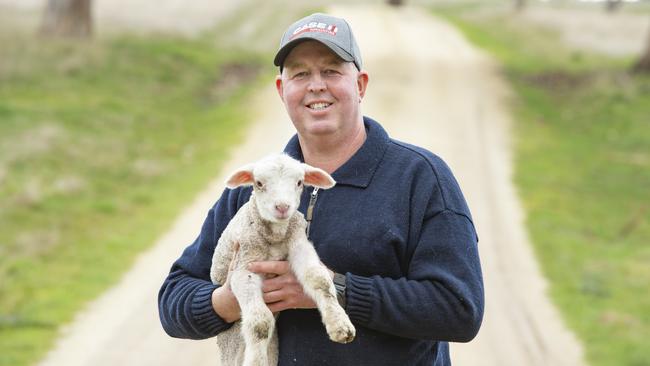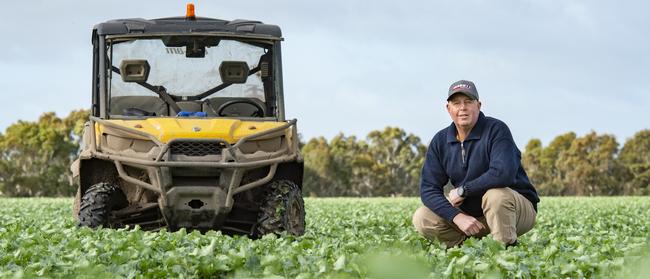Scott Young: Crunching the numbers on a productive farm
This innovative farmer leaves nothing to chance. In fact, Scott Young uses as much information and data as he can on farm.

Farming isn’t a gamble for Scott Young.
In fact, this third-generation sheep and grains farmer from Fiskville, near Ballan in western Victoria, uses as much information and data as he can to make the best decisions on farm, forecasting into the future where possible.
Scott runs about 2000 first-cross ewes on his 850ha family farm, Fernleigh Park. The farm is equally devoted to its cropping operation, which accounts for about 50 per cent of the farm.
But when asked whether he considered himself a grain grower or a sheep producer, Scott said he was neither.
“I’m predominantly a soil farmer … that’s where everything comes from,” Scott said.
Scott bought a disc driller about 10 years ago, a move he said revolutionised his cropping and pasture enterprise.
“I’ve been able to go in, boost up my pastures with inter-sowing and bulking them up, or even sowing summer crops into my stubble for sheep feed, things like that,” Scott said.
“Before that, we used an old-school plough, putting seed in with a conventional seeder.”
Years spent running Merino sheep across the property had reduced the quality of the soil across the farm, Scott said.
“Our pastures and soils had been neglected over the years and run down,” he said.
It was when his father passed on control of the farm to a younger Scott in his early 30s that they realised the farm needed to focus more on producing protein.
“We decided we weren’t going anywhere growing wool, and that we needed to grow protein, as everybody needs to eat,” Scott said.
“We slowly swapped over from Merino to first-cross ewes. Now the prop is a 50-50 split between cropping and livestock, but we’re moving gradually towards livestock.”
The Youngs have grown crops for about 15 years. And in that time the quality of the soil changed “from very unproductive to highly productive rye-grass, clovers”, Scott said.
“I’m finding now I’m making more profit from the livestock than the grains side. That grain side has helped get me where I am now,” he said.
Improving the condition of the farm’s grey loam soil with high clay content has been a priority for Scott.
“When I started cropping it was very acidic, down to 4.3 in some paddocks. I’ve been able to bring paddocks back up to 5-5.5,” Scott said.

“It’s completely changed, we’re running more livestock on a smaller area, they’re healthier, getting the benefits. The difference the lime has made, changing the PH around.”
Running sheep in conjunction to his cropping operation is a key part of both managing the soils on the farm, and spreading seasonal risk.
Scott runs about 2000 first-cross ewes, with the aim to increase numbers in coming years.
Ewes are joined to Southdown and Dorset terminal rams, while meat maternal rams are Dorset crossed with East Friesians.
From the moment a lamb is born, Scott is watching it, monitoring its growth, and noting the data.
“I monitor the growth rates of all those lambs, through the electronic identification tags. I’ve got a sheep handler, and a set of scales, everything goes through the yards gets recorded, monitor all my growth rates,” Scott says.
“By monitoring growth rates I can work out when I’ll have my lambs at the weight I want, when I can take out contracts, and put those lambs in to go. By the time lambs are on the ground – I’ve almost finished lambing now – I’ve got an idea of what the season is going to be, once those lambs com in after making and have their second weights done, I can then forecast from that how many lambs I’ll have to turn off in 30 days time.
“It’s a pretty easy process to do. You put it all into the laptop and it’ll give you feedback for every lamb.”
Scott sells about 95 per cent of his lambs over the hook, and is hopeful in the near future more information will be passed from across the supply chain, such as abattoirs and processing plants, back to producers like himself.
“We can then match that will on farm work, and really be able to narrow down our breeding,” Scott says.
“We’ve got that traceability now in Victoria (through the EID tags) and as more and more people come on and do the record keeping, we’ll be able to trace every animal.”
There are opportunities for Australian sheep meat exports with an international appetite for traceability in the supply chain, Scott says.
“Hopefully in the near future we’ll have feedback from the supply chain and abattoirs, and match that up with our on-farm work and really narrow down our breeding, so we can really maximise our production.”
The start of Scott’s self-professed bean career was impressive, considering he only sowed his first legume crop last season.
“Last year was phenomenal, I had a great start to my bean career,” Scott says.
“I had to make a big compromise last year with the weather. We sowed 50ha of beans, 110ha of red wheat, and about 110ha of canola. The wheat yielded about 10 tonne (a ha) last year.”
Scott employs the skills of agronomists to help assist his decision making on farm, and uses an agronomist from Premier Ag.
“They are really forward thinking, and it challenges what you’re doing, which is what I love as a farmer,” Scott says.
“Farmers are now realising … they did work well in the past, but especially grain growers I think work really well together. There are great organisations such as the Birchip Cropping Group, and Southern Farming Systems, helping people put their ideas into practice.”
It’s this same motivation to learn and collaborate with other producers which saw Scott first get involved in the Victorian Farmers Federation, where he is now vice president of the livestock group.
Spreading the risk is key to survival for Scott. This is despite being in an arable pocket of Victoria.
“I’m very fortunate … I’m in a little piece of God’s country where drought is a fairly rare thing,” Scott says.
“Through being able to hold some grain back, I’ve got my hay and silage each year … and sometimes it’s easier in this area to crop in a dry year than in a wet year.”
By mixing livestock with cropping, Scott says he is able to balance the weather, prices, and other variables which may impact on the profitability of the farm.
“That’s my plan … if cropping is through the roof one year, I’m not going to get the highs of it, but if cropping is down I’ve got my livestock, or if I have a failed crop I’ve got livestock I can run on it, and take advantage of it that way,” Scott says.
“Instead of having three good years in 10, I’d like to have nine average years and one ordinary year, if I can. That’s what I work towards.
“Farming isn’t just vacant land. It’s people’s businesses. My land is by business. Every inch of that land is precious to me.”





